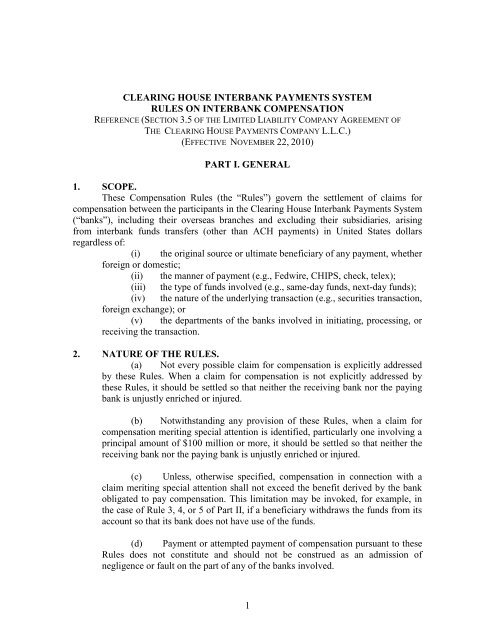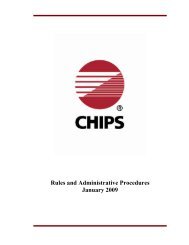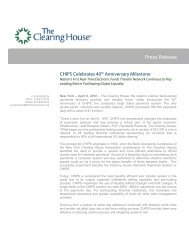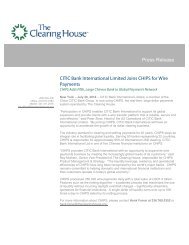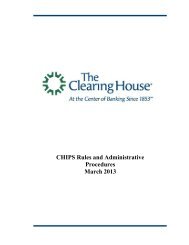RULES ON INTERBANK COMPENSATION - chips
RULES ON INTERBANK COMPENSATION - chips
RULES ON INTERBANK COMPENSATION - chips
You also want an ePaper? Increase the reach of your titles
YUMPU automatically turns print PDFs into web optimized ePapers that Google loves.
CLEARING HOUSE <strong>INTERBANK</strong> PAYMENTS SYSTEM<strong>RULES</strong> <strong>ON</strong> <strong>INTERBANK</strong> COMPENSATI<strong>ON</strong>REFERENCE (SECTI<strong>ON</strong> 3.5 OF THE LIMITED LIABILITY COMPANY AGREEMENT OFTHE CLEARING HOUSE PAYMENTS COMPANY L.L.C.)(EFFECTIVE NOVEMBER 22, 2010)PART I. GENERAL1. SCOPE.These Compensation Rules (the ―Rules‖) govern the settlement of claims forcompensation between the participants in the Clearing House Interbank Payments System(―banks‖), including their overseas branches and excluding their subsidiaries, arisingfrom interbank funds transfers (other than ACH payments) in United States dollarsregardless of:(i) the original source or ultimate beneficiary of any payment, whetherforeign or domestic;(ii) the manner of payment (e.g., Fedwire, CHIPS, check, telex);(iii) the type of funds involved (e.g., same-day funds, next-day funds);(iv) the nature of the underlying transaction (e.g., securities transaction,foreign exchange); or(v) the departments of the banks involved in initiating, processing, orreceiving the transaction.2. NATURE OF THE <strong>RULES</strong>.(a) Not every possible claim for compensation is explicitly addressedby these Rules. When a claim for compensation is not explicitly addressed bythese Rules, it should be settled so that neither the receiving bank nor the payingbank is unjustly enriched or injured.(b) Notwithstanding any provision of these Rules, when a claim forcompensation meriting special attention is identified, particularly one involving aprincipal amount of $100 million or more, it should be settled so that neither thereceiving bank nor the paying bank is unjustly enriched or injured.(c) Unless, otherwise specified, compensation in connection with aclaim meriting special attention shall not exceed the benefit derived by the bankobligated to pay compensation. This limitation may be invoked, for example, inthe case of Rule 3, 4, or 5 of Part II, if a beneficiary withdraws the funds from itsaccount so that its bank does not have use of the funds.(d) Payment or attempted payment of compensation pursuant to theseRules does not constitute and should not be construed as an admission ofnegligence or fault on the part of any of the banks involved.1
3. MANNER OF PAYMENT.Compensation under the Rules shall be paid in United States dollars. Acompensation payment may be made by CHIPS, Fedwire, or check. Banks may alter themanner of payment of compensation by prior mutual agreement.4. BENEFICIARIES.The Rules do not confer any right on any person, entity, or organization not aparticipant in the Clearing House Interbank Payments System.5. THIRD PARTIES.The Rules do not apply to claims for compensation arising from actions of entitiesthat are not participants of the Clearing House Interbank Payments System.PART II. <strong>INTERBANK</strong> FUNDS PAYMENTS1. DEFINITI<strong>ON</strong>S.(a) ―BUSINESS DAY‖ means a Monday, Tuesday, Wednesday,Thursday, or Friday that is not a day on which the office of the bank that underthese Rules is required or expected to perform an action is authorized or obligatedby law or executive order to close.(b) ―FED. FUNDS RATE‖ means the average of each day’s federal fundsrate, as published on a daily basis by the Federal Reserve Bank of New York, forthe days that a bank must include in the applicable formula(s) in calculatingcompensation. The daily Fed. Funds Rate for any day on which a published rate isnot available shall be deemed to be the same as the immediately precedingpublished rate.(c) ―APPLICABLE FDIC ASSESSMENT‖ means the amount of theincrease, if any, in an FDIC assessment payable or paid by the receiving bankbecause the relevant payment increased the base on which the FDIC assessment iscalculated. The amount of the increase will be calculated using the assessmentrate adopted by the FDIC for the lowest risk classification in its risk-relatedschedule.2. BACK VALUATI<strong>ON</strong>.(a) A bank that sent a payment may request the bank that received thepayment to back value such payment. Generally, such request is accompanied bya payment for the amount of compensation owed pursuant to the formula below.If compensation is paid, the receiving bank is obligated to back value the paymentto the date requested, unless (i) its customer instructs it not to back value suchpayment, (ii) the account has been closed, (iii) the sending bank requests a back2
valuation to a date more than one year prior to the payment date, or (iv) thecompensation payment is received more than one year after the payment date.(b) If the receiving bank back values the payment pursuant to therequest of the sending bank, the sending bank must pay the receiving bankcompensation according to the following formula (without regard to whether ornot the beneficiary’s account was actually in an overdraft position):Compensation =(Dollar Amount of Payment) (Fed. Funds Rate) (No. of Days Back Valued) + $300*360*$300 is paid to the bank that received a payment tocompensate it for its administrative costs in back valuing apayment.3. FORWARD VALUATI<strong>ON</strong>.(a) A bank that sent a payment may request the bank that received thepayment to adjust the payment to a future value date. The receiving bank is notobligated to make such an adjustment.(b) If a receiving bank adjusts the payment to a future value datepursuant to the request of the sending bank, the receiving bank must, uponreceiving a claim for compensation within 60 days from the date on which therequested adjustment was made, pay the sending bank compensation according tothe following formula:Compensation =(Dollar Amount of Payment) (Fed. Funds Rate) (No. of Days Forward Valued)360— ($300* + Applicable FDIC Assessment)*The $300 deduction is allowed to compensate the receiving bank for itsadministrative costs in adjusting a payment to a future date. The receiving bank is notentitled to the $300 deduction if a request for a change of beneficiary (Rule 5) alsoaccompanies a request for forward valuation.(c) A receiving bank that claims an Applicable FDIC Assessmentwarrants to the sending bank that such amount (or at least the amount calculatedat the lowest risk-related assessment rate) is payable or has been paid by it to theFDIC and has not been and will not be recovered. If a receiving bank adjusts thepayment pursuant to the request, the receiving bank is entitled to compensationfor an Applicable FDIC Assessment even if the sending bank does not claimcompensation. However, a receiving bank’s claim for an Applicable FDICAssessment in such a situation must be made within 60 days from the date onwhich the requested adjustment was made.3
(d) If a claim for compensation has been made by the sending bankand the compensation is calculated to be zero or a negative number, neither thereceiving bank nor the sending bank shall pay any compensation unless a claimfor an Applicable FDIC Assessment has been made. However, if a claim for anApplicable FDIC Assessment has been made and the compensation is calculatedto be a negative number, the sending bank shall pay the receiving bank theamount of compensation calculated, i.e., the absolute value of the negativenumber calculated, provided such value is $1,000 or greater. If a claim forcompensation has not been made by the sending bank and the receiving bank hasmade a claim for an Applicable FDIC Assessment, the sending bank shall paycompensation provided the value of such claim is $1,000 or greater.4. RETURN OF “MISSENT PAYMENT.”(a) A bank that has sent a payment may request the bank that receivedsuch payment to return the funds. For example, a bank that has sent a paymentthat should have not been sent, sent a payment to the wrong bank, has sent aduplicated payment or has made an overpayment (each such payment or partthereof constituting an overpayment is hereafter referred to as a "missentpayment"), may request the bank which received the missent payment to return it.To induce the receiving bank to return a missent payment the sending bank mayissue an Indemnity conforming to the Clearing House Interbank Payments SystemCompensation Indemnity and Responses (―Indemnity‖) (Appendix A). Thereceiving bank is not obligated to return the payment in reliance on the Indemnity.(b) Except as provided under Rule 7 of this Part II, if a receiving bankreturns a missent payment on any business day other than the day of its receipt, itshall, upon receiving a claim for compensation within 60 days from the date onwhich it returned the missent payment, pay the sending bank compensationaccording to the following formula:Compensation =(Dollar Amount of Payment) (Fed. Funds Rate) (No. of Days Not to Exceed 180)360— (Applicable Deduction) + (Applicable FDIC Assessment)(c) If a missent payment is retained by the receiving bank for morethan 180 days, the Fed. Funds Rate means the Fed. Funds Rate in effect during themost recent 180-day time period.(d) ―APPLICABLE DEDUCTI<strong>ON</strong>‖ means (i) $750 when a missentpayment is returned no later than two business days after the date of receipt of anIndemnity, or when a missent payment is returned without receiving anIndemnity; or (ii) $300 in all other cases.(e) A receiving bank that claims an Applicable FDIC Assessmentwarrants to the sending bank that such amount (or at least the amount calculatedat the lowest risk-related assessment rate) is payable or has been paid by it to the4
FDIC and has not been and will not be recovered. If the missent funds arereturned to the sending bank, the receiving bank is entitled to compensation for anApplicable FDIC Assessment even if the sending bank does not claimcompensation or requests another party to return the funds. However, a receivingbank’s claim for an Applicable FDIC Assessment in such a situation must bemade within 60 days from the date the missent funds were returned.(f) If a claim for compensation has been made by the sending bankand the compensation is calculated to be zero or a negative number, neither thereceiving bank nor the sending bank shall pay any compensation unless a claimfor an Applicable FDIC Assessment has been made. However, if a claim for anApplicable FDIC Assessment has been made and the compensation is calculatedto be a negative number, the sending bank shall pay the receiving bank theamount of compensation calculated, i.e., the absolute value of the negativenumber calculated, provided such value is $1,000 or greater. If a claim forcompensation has not been made by the sending bank or another party hasreturned the funds and the receiving bank has made a claim for an ApplicableFDIC Assessment, the sending bank shall pay compensation provided the value ofsuch claim is $1,000 or greater.(g) A bank that returns a missent payment on the day of its receiptupon receiving an Indemnity is entitled to $300 for its administrative costs inreturning the payment but to no other compensation.5. CHANGE OF BENEFICIARY (PAYMENT TO ANINCORRECT ACCOUNT OR N<strong>ON</strong>-EXISTENT ACCOUNT).(a) A bank that has sent a payment to the correct bank but indicatedthe payment was for credit to the wrong account or omitted the credit accountmay request the bank receiving the payment to adjust the payment to the correctaccount on its books. To induce the receiving bank to adjust a payment to thecorrect account, the sending bank may issue an Indemnity. The receiving bank isnot obligated to adjust the payment in reliance on the Indemnity. Moreover, manybanks will frequently refuse to adjust a payment if the request to do so is mademore than 180 days after the payment date.(b) If a receiving bank adjusts a payment on any business day otherthan the day of its receipt, the sending bank must, upon receiving a claim forcompensation within 60 days from the date the payment was adjusted, pay thereceiving bank compensation as follows:(i) $300 for making a beneficiary change between two of thereceiving bank’s foreign branches; or(ii) in all other cases according to the following formula(without regard to whether or not the beneficiary’s account was actually inan overdraft position):Compensation = $300*5
*$300 is paid to a receiving bank for its administrative costs in applying a payment to acorrect account.(c) A bank that adjusts a payment to another account on its books onthe same day it received such payment upon receiving an Indemnity is entitled to$300 for its administrative costs in applying the payment to the correct accountbut to no other compensation.(d) If a back valuation request accompanies a request for change inbeneficiary, the compensation provisions of Rules 2 and 7 of this Part II also shallapply. If a request for forward valuation accompanies a request for change inbeneficiary, the compensation provisions of Rule 3 of this Part II also shall apply.6. CASH C<strong>ON</strong>CENTRATI<strong>ON</strong> DRAWDOWN REQUEST.(a) LATE RESP<strong>ON</strong>SE TO A CASH C<strong>ON</strong>CENTRATI<strong>ON</strong> DRAWDOWNREQUEST. When a bank has sent an authorized cash concentration drawdownrequest to another bank, within the appointed time, but payment pursuant to suchrequest is not made on the anticipated business day, the bank making thedrawdown request may request and obtain compensation according to thefollowing formula:Compensation =[(Amount of Payment) (Fed. Funds Rate) (No. of Days a Payment Was Delayed)]360+ $300**$300 is allowed to compensate the requesting bank for its administrative costs involved.(b)[Reserved](c) ―APPOINTED TIME‖ under this Rule means within the time periodspecified for responding to such pre-authorized drawdown requests in theagreement governing such requests and responses between the requesting andsending banks.7. NETTING OF COMPENSATI<strong>ON</strong>.In the following instance, compensation shall be netted as described below.Bank A sends a payment to Bank B with incorrect beneficiary information. BankB returns the payment, unable to apply. Bank A resends the payment with correctinformation and a request for back valuation.Bank B applies payment to the correct account.Bank A owes Bank B 100% compensation for back valuing a payment to the dayit originally sent the payment from the day that Bank B applied the payment from thecorrect account (including a $300 fee), minus compensation owed by Bank B to Bank A6
for use of funds from the day Bank B originally received the payment to the day itreturned the payment, unable to apply. However, Bank B is not entitled to any applicablededuction from the compensation owed Bank A in connection with its returning thepayment, unable to apply.7
Appendix ACLEARING HOUSE <strong>INTERBANK</strong> PAYMENTS SYSTEMCOMPENSATI<strong>ON</strong> INDEMNITY (THE “INDEMNITY”) AND RESP<strong>ON</strong>SES1. PURPOSE AND SCOPE.The Indemnity that appears below is intended to be used by a bank sending aUnited States dollar payment (the ―Paying Bank‖) in order to induce a bank receiving thatpayment (the ―Receiving Bank‖) to act in an expeditious manner in one of the followingtwo circumstances: (a) returning a missent payment or (b) adjusting a credit to the correctaccount when a payment was made to the correct Receiving Bank but for credit to anincorrect or non-existent account. When the Paying Bank issues the Indemnity, theReceiving Bank may rely on it, but is not obligated to act as requested by the Indemnitymerely as a result of having received it. The Indemnity is not intended to be used incircumstances other than those set forth in (a) and (b) above or where the only reason forrequesting the return or adjustment of a payment is the erroneous or unauthorized actionof a third party. In such circumstances, claims for compensation are not governed bythese Rules (see Rule 5 of Part I), and the banks involved should take actions and resolveany liabilities arising from the payment based on the facts of the individual case.Notwithstanding the foregoing, in any case where the Indemnity is issued by a PayingBank and relied upon by a Receiving Bank, the Paying Bank is obligated (a) to indemnifythe Receiving Bank in accordance with the terms of the Indemnity and (b) to comply witha Return of Funds notification pursuant to Section 7 of this Appendix A.If a Receiving Bank, after accepting a payment order, returns or adjusts thepayment in response to a request (whether oral, written, or electronically transmitted) that(a) does not expressly offer an indemnity to the Receiving Bank from the Paying Bankand (b) is not a Fedwire subtype code 01 message (request for reversal) or a Fedwiresubtype code 07 message (request for reversal of prior day transfer), then the PayingBank shall not have any liability to the Receiving Bank either under the indemnity thatappears below or that might otherwise arise from the application of Section 4-A–211 (6)of the New York Uniform Commercial Code.2. METHOD OF TRANSMISSI<strong>ON</strong>.A Paying Bank should transmit the Indemnity and a Receiving Bank shouldtransmit any response or release thereof, by telex, S.W.I.F.T., any other mutually agreedupon means of electronic transmission, or by letter. It is recommended that theIndemnity be sent by means of electronic transmission. If transmitted by telex, the telexmust bear the sender’s test key number. If transmitted by S.W.I.F.T. or any other meansof electronic transmission, the transmission must be authenticated. If transmitted byletter, the letter must be executed by an authorized signatory of the sender and must behand delivered to the receiver by an authorized messenger from the sender. The receivershall acknowledge receipt of such a letter. Such acknowledgment shall be considered8
proof that such letter was properly delivered by the sender to the receiver. If transmittedby letter, each Indemnity must be enclosed in a readily identifiable envelope addressed tothe Receiving Bank clearly marked with the notation ―Indemnity.‖3. FORMAT.(a)The Indemnity must be in the following format:INDEMNITYREF. NO.With reference to our payment date by means of (Fedwire# , CHIPS # , S.W.I.F.T. # , or check #,) for U.S. $ in your favor (for the account of) by order of , we request that you:[ ] Adjust the credit from the account ofto the account of[ ] Refund the amount of U.S. $that was not intendedfor you;[ ] Refund the amount of U.S. $because the aaforementioned payment wasa duplication of (Fedwire # ,CHIPS #,S.W.I.F.T. # , or check # );[ ]Refund the amount of U.S. $that was an overpayment.The correct amount should be U.S. $;[ ] Pay us compensation calculated pursuant to theClearing House Interbank Payments System Rules on InterbankCompensation from (payment date to the date on which you fulfillthis request).In consideration of your complying with the terms of this Indemnitywe agree to indemnify you and your officers and employees against anyand all claims, liabilities, losses, expenses, (including the reasonable feesand disbursements of your counsel) suits or damages resulting therefrom(each of the foregoing is hereinafter referred to as “loss”). We also agreeto reimburse you for all costs and expenses for collection or otherwise(including the reasonable fees and disbursements of your counsel) inconnection with your good faith efforts to enforce or preserve any of yourrights under this Indemnity.We represent and warrant that we are duly authorized by allnecessary and appropriate corporate action to execute this Indemnity and9
that this Indemnity is a valid and legally binding obligation of our bank.You agree to notify us of any such loss within ten business days of yourreceipt of notification of any such loss.Pursuant to a Recall of Funds notification as provided under theClearing House Interbank Payments System Compensation Indemnity andResponses, we will return on demand the amount refunded by you orreimburse you on demand for the amount of the adjustment.You agree to contact your customer immediately to obtain its debitauthorization. Upon receiving such debit authorization, our obligationsunder this Indemnity will cease and you will notify us of your releasehereunder. Please make the appropriate response to this Indemnity.(b) The Indemnity may be sent in an abbreviated format when it bearsthe statement: ―We agree to indemnify you according to the Clearing HouseInterbank Payments System Indemnity and Responses. (Ref. No. ).‖ Suchstatement will be deemed to incorporate the entire text of the Indemnity set forthabove. The following information must also be provided in the abbreviatedformat:(1) Date of transfer(2) Amount of transfer(3) Method of transfer(4) Payment system identification(a) Fedwire number(b) CHIPS number(c) S.W.I.F.T. number(d) Check number(e) Account number for party to whom payment wasoriginally sent(f) Account number of party to be credited(5) By order party(6) Description of action requested (including claim forcompensation).(c) The Indemnity may be given by sending structured formattransaction codes established by procedures as set forth from time to time in theCHIPS Systems and Operations Manual for CHIPS participants to send and receivesuch indemnities. Such procedures permit the Paying Bank to cause CHIPS totransmit to the Receiving Bank a CHIPS service message that contains either thestatement: “We indemnify you under CHIPS or IFSA Compensation Rules asapplicable (Ref. No.)” or a structured format transaction codeestablished by such Manual for such indemnities. Such CHIPS service message willbe deemed to incorporate the entire text of the Clearing House Interbank PaymentsSystem Indemnity set forth above between participants in the Clearing HouseInterbank System ("CHIPS participant") and, to the extent permitted by International10
Financial Services Association Interbank Compensation Rules, shall be deemed toincorporate the entire text of the IFSA Indemnity set forth in its Compensation Rulesbetween a CHIPS participant and an IFSA member bank or between two IFSAmember banks. The following information must also be provided in the CHIPSservice message:(1) Identification of the CHIPS payment message by which thetransfer was made as follows:(i) Paying Bank’s payment sequence number (―PSN‖)(ii) Amount of transfer(iii) Date of transfer.(2) Identification of the parties (by name or account number orboth where available but not merely by the CHIPS Universal Identificationnumber) as follows:(i) Party to whom payment was originally sent(ii) By order party(iii) Party to whom corrected payment shall be made (ifapplicable).4. RESP<strong>ON</strong>SES.(a) When a Receiving Bank determines it will return principalpursuant to an Indemnity, principal should be returned by CHIPS or Fedwire, andthe Receiving Bank should notify the Paying Bank as follows:Returning your (Fedwire #_______, CHIPS # ,S.W.I.F.T. # , or check # _____) dated for $pursuant to your Indemnity Ref. No.dated[We are forwarding the appropriate compensation.](b) When in reliance on an Indemnity a Receiving Bank determines toadjust the beneficiary’s account and account number, the Receiving Bank shouldnotify the Paying Bank as follows:On (date), we adjusted your (Fedwire # , CHIPS #, S.W.I.F.T. # , or check # ) to read(beneficiary and amount) pursuant to your Indemnity Ref. No.dated . Please forward compensation of $ .(c) When a Receiving Bank determines to take no action on anIndemnity because it contains insufficient information or is not in the standardformat, the Receiving Bank should notify the Paying Bank as follows:Your Indemnity delivered by (S.W.I.F.T., telex, letter) Ref. No.dated for $ covering11
instructions (Fedwire # , CHIPS # ,S.W.I.F.T. # , or check # ) dated by order ofcannot be acted upon because it contains (IncorrectFormat, Incomplete Information, or Inappropriate Transmittal).(d) When a Receiving Bank in its sole discretion determines not totake action requested by the Indemnity, the Receiving Bank shall notify thePaying Bank as follows:We have determined to take no action pursuant to your Indemnitydelivered by (S.W.I.F.T., telex, letter) Ref. No. datedfor$ _________ covering instructions via (Fedwire # , CHIPS #__________, S.W.I.F.T. # , or check # ______) dated_____________ by order of(We are treatingthe matter as an inquiry and are today, (date), seeking debit authorizationfrom our customer. We shall advise you of its response.)5. C<strong>ON</strong>FIRMATI<strong>ON</strong>.If the Receiving Bank determines to take the action requested by the Indemnity, itshall attempt to procure confirmation of its action from the party whose account wasdebited. The Receiving Bank shall notify such party as follows:On (date), we debited your account # for $ inreversal of a credit entry dated _____________, our Ref. No. , customerRef. No. by the order of for the order of Thepaying bank notified us that it had incorrectly instructed us to credit your account.Please notify us that we have correctly debited your account.6. RELEASE.At the earlier occurrence of one of the following two events, the Paying Bankshall no longer be liable to the Receiving Bank (i) on the Indemnity or (ii) in connectionwith any matter, cause, or thing whatsoever related to or arising from such Indemnity, orrelated to or arising from any transactions, occurrences, or events to which suchIndemnity relates: (a) the Receiving Bank has received debit authorization from itscustomer, or (b) the Receiving Bank, by a means set forth herein, notifies the PayingBank that it releases the Paying Bank of its obligations and liabilities arising from and inconnection with such Indemnity or any transactions, occurrences or events to which suchIndemnity relates.The Receiving Bank should notify the Paying Bank of the release of theindemnity as follows:12
We hereby notify you that you have been released from all obligations andliabilities whatsoever arising from and in connection with your Indemnity or relatedto or arising from any transactions, occurrences or events to which such Indemnityrelates, delivered by (S.W.I.F.T., telex, or letter) Ref. No.datedfor $ covering instructions via (Fedwire # , CHIPS #, S.W.I.F.T. # , or check # ) datedby order of .)An Indemnity may be released in an abbreviated format as follows:We hereby notify you of the release of your Indemnity (Ref. No. )according to the Clearing House Interbank Payments System’s Indemnity Responses.Such statement will be deemed to incorporate the entire text of the release set forthabove. Necessary identifying information, including means of transfer, date, and thesource and date of instructions, should be included.The Receiving Bank should transmit a notice of release of an Indemnity by telex,S.W.I.F.T., any other mutually agreed upon means of electronic transmission, or letter. Itis recommended that such notice be sent by means of electronic transmission. Iftransmitted by telex, the telex must bear the sender’s test key number. If transmitted byS.W.I.F.T. or any other means of electronic transmission, the transmission must beauthenticated. If transmitted by letter, the letter must be executed by a signatory of thesender who has the authority to bind the bank in such matters and must be handdelivered to the receiver by an authorized messenger from the sender.The receiver shall acknowledge receipt of such a letter. Such acknowledgmentshall be considered proof that such letter was properly delivered by the sender to thereceiver. If transmitted by letter, each notice must be enclosed in a readily identifiableenvelope addressed to the Paying Bank clearly marked with the notation ―Notice ofRelease of Indemnity.‖7. RECALL OF FUNDS.If the beneficiary whose account has been debited by the Receiving Bankpursuant to a request by a Paying Bank in the Indemnity requests the return of the amountso debited, the Paying Bank must, as the case may be, return, or reimburse the ReceivingBank for, such amount upon receipt of the following notice from the Receiving Bank:Please (return to us or reimburse us) in the amount of $ whichwe refunded to you via (Fedwire # , CHIPS #, or ) (or credited to the account ofpursuant to the Indemnity delivered by (S.W.I.F.T., telex, or letter) Ref. No.dated covering instructions via (Fedwire #, CHIPS # , S.W.I.F.T. #, or check # ) dated13
funds.by order ofbecause our customer has demanded a return ofThe obligation of the Paying Bank to pay the Receiving Bank is independent of and isnot affected by the Paying Bank’s obligations under an indemnity issued to theReceiving Bank pursuant to this Appendix A.14


